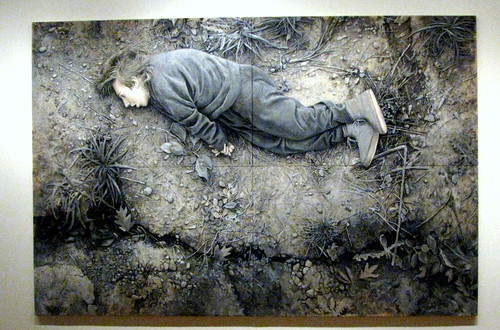More specifically, an art writer's catalog description of the work pissed me off. The painting itself only made me uncomfortable. And curious.
Temma on Earth (Tim Lowly, 1999) hit me hard. My impression of the work and my emotional reaction was disconcerting and uncomfortable: This is a crime scene. This child is a victim. Good god, who would paint such a thing, and why?
The work hanging opposite of Temma only reinforced my impression. Robert McGurdy's untitled work is a large photorealistic oil-on-canvas portrait of an expressionless man and woman, looking straight on - - as if to bear witness to the crime across the room.
I was uncomfortable enough with Temma to later research it on teh internets. Temma is a portrait of the artist's child, physically and mentally disabled since birth. This backstory fits my initial impression of the work and what was visually communicated: a tragedy, a child who isn't living the life we wish for her. Deep sorrow. Inability to change the outcome. Ok. Get it.
My irritation is not with Temma or the artist. Rather, it is with a catalog description of Temma in which the writer completely recasts the work as something uplifting and even "peaceful." In a 2001 essay, John Brunetti describes the piece using words such as poetic expression, calmly rests, peaceful, free of the earth's gravity, luminously celestial, lighter than air, transcend. Are. you. f*cking. crazy? Are we looking at the same painting?
The hubris and I'm-smarter-than-you attitude of many art critics and writers is what turns off ordinary people from the art world. I honestly and truly do appreciate backstory and context of a work: it deepens an understanding of the piece and of the artist. However, at the end of the day a painting is a visual communication medium and a good one must be able to stand on its own visually, without reliance on context to explain, nor require backstory to help a viewer get 'the point."
Should art critics and art writers to use context and backstory to completely recolor an art work's visual message?
Hell no. By doing so, the art establishment creates a self-serving barrier between the artist and the viewer, as in: "You little ordinary people can't understand or appreciate a work unless one of us important and much more knowledgeable people interpret it for you."
To that I say, "F*ck you."
Thursday, November 20, 2008
This painting pissed me off
Posted by Jeanine Anderson at 11/20/2008 11:38:00 AM
tags: art, Frye Art Museum, opinion
Subscribe to:
Post Comments (Atom)

2 comments:
Yet another reason I need to get over to the Frye soon. I'd like to see this in person.
I agree about art critics, too; sometimes it's so aggravating to read someone commenting on an artwork I adore... they might expose some weakness, or just misinterpret some aspect of it in a way I can't get out of my head. Writing about art can be an art in itself, and it's so much more of a waste when it's done poorly!
Other people's interpretations are always enlightening and educational. I think I'm over my fit of pique now.
If you make it to the Frye, look for Steven Assael's IRT #7. The color, lighting, and placement is a mash-up of Alex Ross and the Hildebrandt Bros, applied to a modern urban scene.
Post a Comment